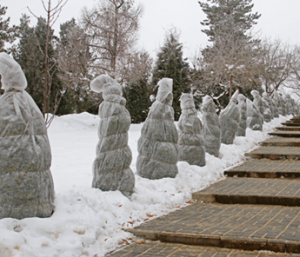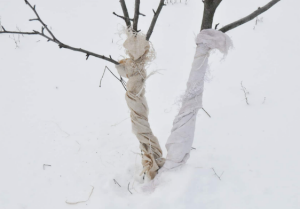Submitted by Doreen Coyne, a member of the Richmond Hill Garden & Horticultural Society
You may recall seeing trees and shrubs wrapped up in burlap as you drive through a residential area. Over the years, I’ve seen fewer of these and began to wonder why people do it and others don’t.
There are several reasons for this.
- Dry winter winds can damage evergreens. In exposed, windy areas, wrapping shrubs with burlap or easy-to-use shrub wraps will help. An alternative is to build a windbreak (small fence) on the exposed sides of the plant
- Another common reason for wrapping plants is to support branches which could be damaged or broken from snow and ice load over the course of the winter.

How?
- Put the wrap on in the fall and remove it in the spring after the last frost.
- Burlap, tarps, sheets or blankets give the best insulation.
- These are readily available from a nursery, Lee Valley, Big Box Stores, and even Amazon.
- Do not use brown paper tree wrap or black colored tree guards as they will absorb heat from the sun which can be too drying to the plant.
- For the better protection, some suggest turning that windbreak into an entire enclosure built using a frame around the plant. Add extra mulch around the base of the plant to blanket the soil and ensure that the windbreak structure doesn’t touch the plant. Extend the covering all the way to the ground to retain heat radiating from the soil so the plants can benefit from it.

Which shrubs/trees need this?
- Wrap newly planted trees for at least two winters.
- Young trees, benefit from burlap wrapped around their trunks.
- Wrap thin-barked species up to five winters or more. When buying a tree or shrub, remember to ask the nursery staff what is best for the specific plant you are purchasing.
- Burlap makes great frost protection for in-ground plants and potted shrubs or trees that are too heavy to move
- Delicate trees such as citrus should be potted and brought indoors if the temperature is like that in Richmond Hill which can go well below freezing. Citrus plants start to be hurt when the temperature nears the freezing point.
What to do if your evergreens turn brown over the winter? There are a few reasons for this so let’s consider common problems.
- Dry Winds: The Evergreen’s roots rely on water stored in tree needles once the ground freezes. This can drain the tree’s water quickly, causing the needles to turn brown from dryness. If wrapping the tree, ensure you wrap the tree all the way to the soil. Of course, you’d need to spray it before wrapping the tree and if not wrapping it, then you can apply the spray in both November and February. These sprays are known as anti-desiccant sprays which provide a waxy coating to shield the plants from moisture loss. Spray when the temperature drops to 4 to 10 degrees Celsius and there’s no rain forecast for at least 24 hours.
- Dry air + Sunny days: This combo dries out your tree’s needles faster and is known as sunscald. Spraying with the protective spray is important and if some of the bark is dried or dead, and you didn’t wrap the tree, then wrap the bark of the tree trunk in burlap to keep the areas warm and protected from the weather. Of course, this is best done preventively before the problem occurs.
- Pests and disease: Evergreens attract a few common pests and diseases, like the pine beetle or cytospora canker disease. Browning needles can be a symptom of infection, along with small holes, sawdust or white sap leaking on the branches. Wrapping is not going to help in this case. Please call your local arborist for help.

